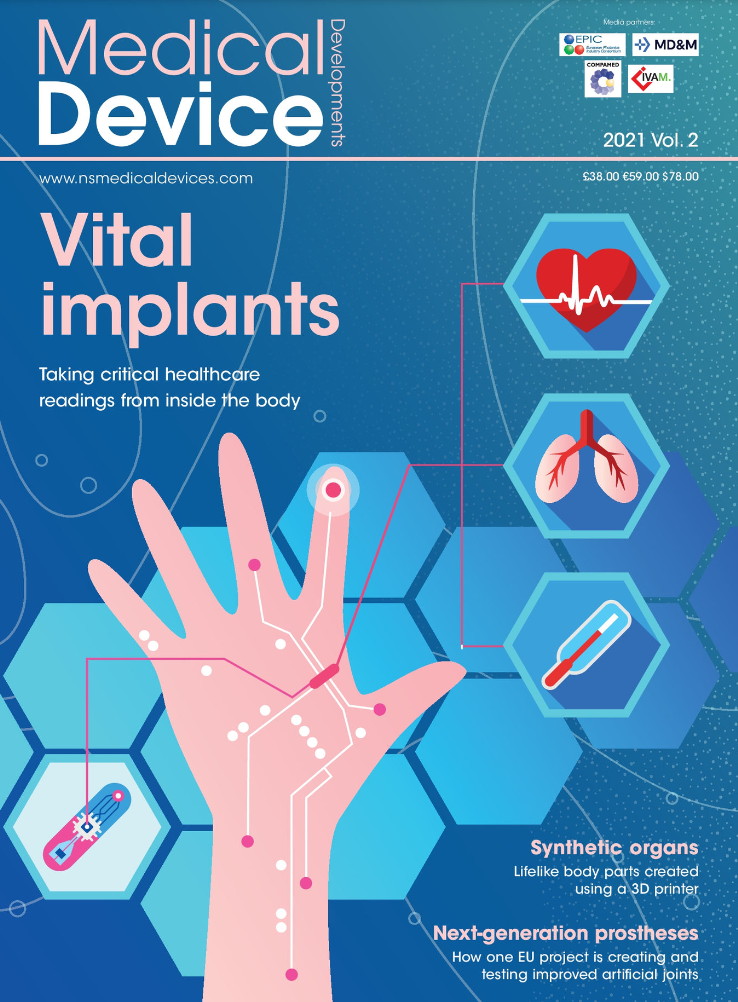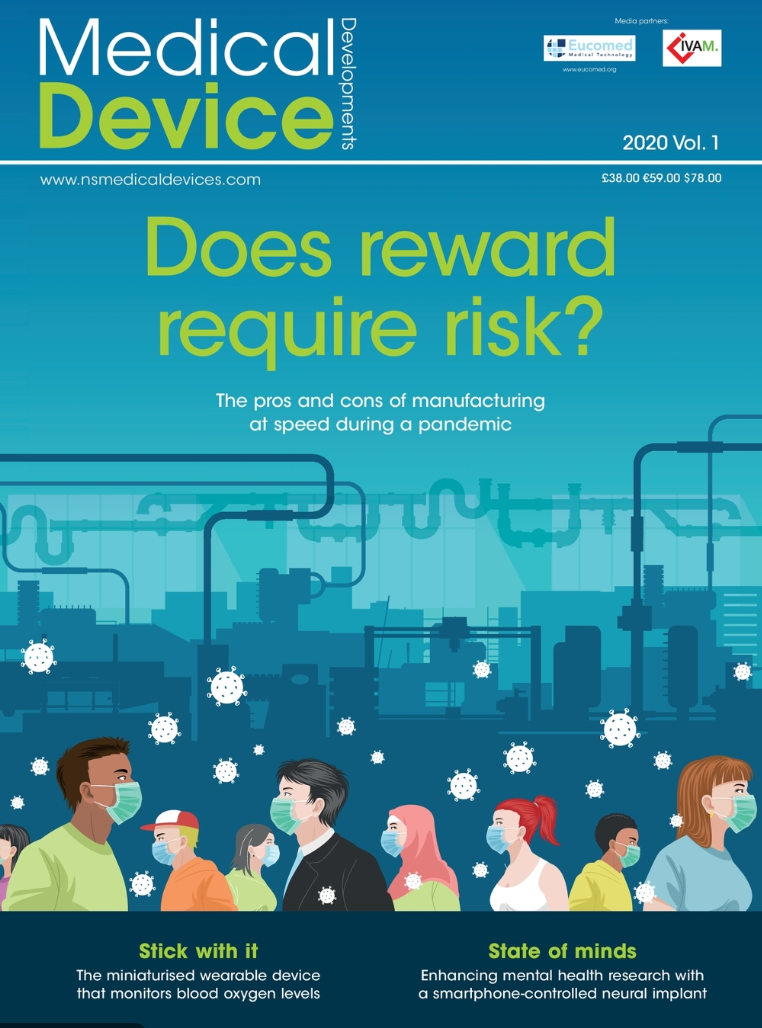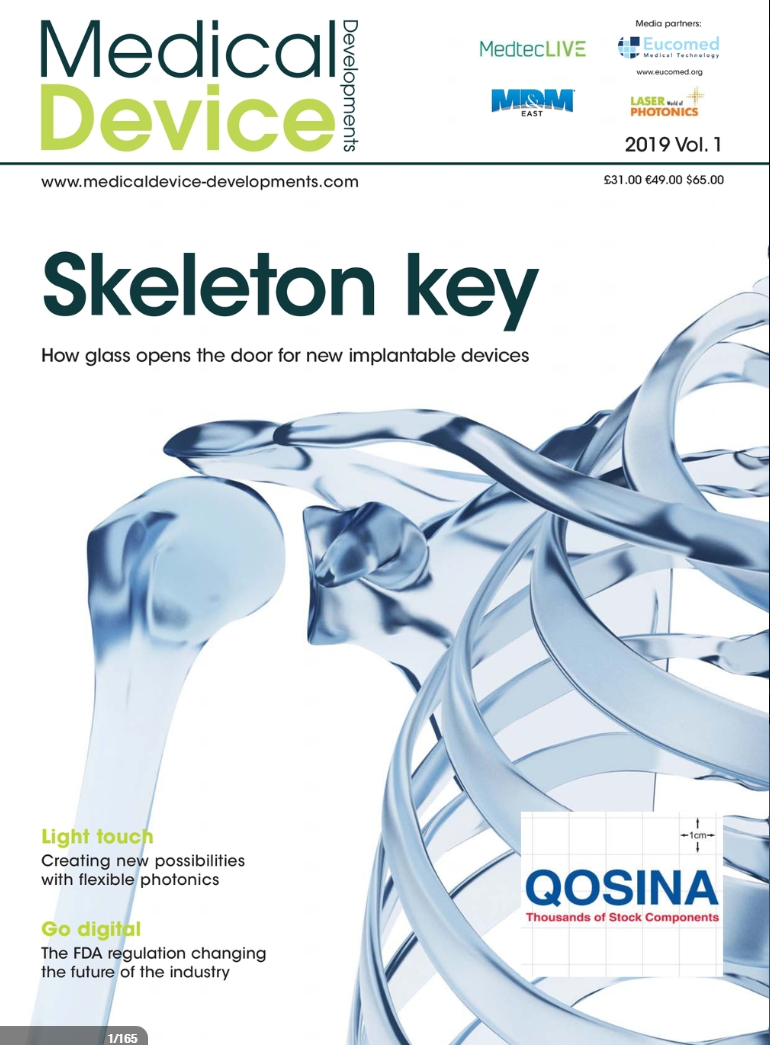
The medical device and diagnostic industry is currently valued at over $350 billion. Technological advances in medical device and diagnostics design are driven by an increasingly demanding market and legislative requirements. A growing patient population and a worldwide governmental drive towards preventive therapies are also fuelling the development of innovative devices.
Medical Device Developments is published in response to the increasing information needs of the major global medical device manufacturers/OEMs. The publication, which is published biannually, will incorporate authoritative reviews of current trends and emerging technologies, and provide the industry’s decision-makers with clear, concise and unbiased technical articles and case histories on cutting edge developments, products and applications, drawing on the expertise of leading engineers and designers from around the globe.

This issue’s cover story: Even the most bio-available implant materials have a level of failure risk. Most require the use of special coatings or the support of drugs, that’s why biomedical engineers have spent countless hours experimenting with materials compatible for use in the human body. 3D-printing technology is helping to accelerate this process by allowing researchers to have greater flexibility when fine tuning the blend of materials in the bio-ink that will determine the properties of the final product. Dermot Martin speaks to two experts in the field to learn how their work could lead to materials with a unique combination of properties.
Outside of materials science, there’s an area of study that’s had a marked impact on healthcare – more specifically in the field of surgery – for years. The use of minimally invasive tools like laparoscopes and endoscopes mean that many surgical interventions that once required long stays in hospital are now done as outpatient procedures. Andrea Valentino talks to Dr Paula Gomes of the British Standards Institution to learn about the advantages of minimally invasive technology, the role that contract manufacturers can play in meeting the demand for products, and how robotics and AI could bolster the field further.

This issue’s cover story: Automation has brought efficiency and cost benefits across a range of manufacturing industries – but what happens when a mistake can pose a risk to the end user? This is the question medical device manufacturers must answer, something they do with high-tech inspection protocols, ensuring each unit is produced to an exact specification. Andrea Valentino talks to Ken McClannon at Jabil Healthcare, and Professor Anil Bharath at Imperial College London, to understand how these so- called vision systems work and how they might be boosted by machine learning technology.
Manufacturing is just one case in which predictability driven by technology can add significant value to the field of medical devices. In one of the major frontiers of the industry, mastery of bioelectronics, there’s a whole host of devices in research labs held back from the clinic by their inability to conform to the complex surfaces of the human body. Peter Littlejohns speaks to a research duo that may have solved that problem for some, using simulation software driven by mathematical modelling to ….

This issue’s cover story: We’re always hearing about the latest promising development for treating cancer, but the tried-and-true methods could still do with a dose of risk-reduction. For instance, nearly half of all cancer patients will undergo radiotherapy, and yet devices used to protect healthy tissue tend to be standardised and not patient-specific. Kim Thomas speaks to two experts in the field to find out how 3D printing is bringing more individualised protection to market, and reducing the risk of damaging healthy tissue.
Turning our attention to another area of medicine that carries patient risk, we look at the role that silver could play in eliminating bacteria from catheters. Among UTIs acquired in the hospital, approximately 75% are associated with a urinary catheter, which is why researchers looking at a new way to take advantage of silver’s bactericidal properties while reducing its toxicity see coating catheters as the perfect use case for their coating. Abi Millar speaks to the lead researcher.

This issue’s cover story: Space exploration has yielded many scientific developments over the years, with healthcare one of several areas that has benefited. Both NASA and the International Space Station (ISS) Laboratory recently signalled their desire to continue this trend by seeking new proposals to demonstrate the manufacture of biomaterials in microgravity. Mae Losasso finds out what could be possible from several experts in the field.
There’s plenty of innovation going on right here on earth, and in a recent feat of engineering, a team at University of California San Diego managed to increase the resolution of electrocorticography sensors by 100x the standard seen in surgical theatres. Tim Gunn learns just how transformative the technology could be for neurosurgery departments by speaking to the duo looking to bring the device to the market.
It’s an unfortunate fact that innovations without a clear and measurable patient impact don’t tend to enjoy the same prestige as those indicated in life-saving treatments.

This issue’s cover story: It’s best not to advertise this to vaccine refusers, but microchips are being injected into people – in clinical trials, at least. They’ve been touted for their ability to constantly monitor patient vitals, allowing for more reactive treatment, as well as better monitoring of long-term conditions. Mae Losasso assesses their potential with Daniel Andersson, associate professor in physiology at Karolinska University Hospital in Sweden, who recently ran a study into using chips for temperature monitoring; and Chen Shi of Columbia University, designer of a chip no larger than a mote of dust.
There’s a considerable amount of future gazing in this issue when it comes to implants; even those of a more traditional nature. Hip and knee replacements are two of the most common operations carried out in orthopaedic departments, but that doesn’t mean they’ve been perfected. There’s constant development into new technologies in the field that can improve, among other things, the longevity, biocompatibility and strength of artificial joints.

This issue’s cover story: Prosthetics are among the original medical wearables, but technological advances haven’t necessarily made them more popular. Answering why might just unlock the potential of a whole range of other devices. Tim Gunn finds out how new approaches to control, comfort and feedback are helping scientists understand how biology overlaps with technology, and enabling users to better identify with their artificial limbs.
That work is only becoming more applicable across the industry. Whether the technology monitors, manages or stimulates, someone’s probably trying to make it into a wearable, but few manufacturers are likely to achieve the balance of innovation and functionality necessary to make a meaningful breakthrough. In the first of a number of articles offering a deep dive into the world of wearables, Abi Millar explores the development strategies behind some notable success stories.

This issue’s cover story: The topic on everyone’s mind is, of course, Covid-19, which has now infected over 3 million people worldwide. Medical device companies have been playing a crucial role in responding to the pandemic, particularly while ventilation has been the lone treatment for the most severe cases. As the UK scrambled to increase its stockpile of breathing aids, it was the country’s Formula One teams that made the most telling impact, but why did they succeed where other non-specialist manufacturers have failed? Tim Gunn discusses the advantages of high-speed techniques like rapid prototyping for the industry with Chris Hurlstone, director of engineering at Team Consulting.
Covid-19 might be disruptive for the industry, but the wide-ranging innovations that have long defined it certainly haven’t stopped. Will Moffitt speaks to Michael Bruchas, professor of neurobiology at the University of Washington School of Medicine, about a tiny neural implant developed by the Korea Advanced Institute of Science and Technology. As it’s controlled from a smartphone, it could turn the devices we’re most familiar with into platforms for researching mental health issues like addiction and depression.

On the cover this issue: Bouncing, bending and bonding to bone, glass is looking more and more like a miracle material. The liquid-like solid is showing its worth in everything from healing wounds to replacing intervertebral discs. Tim Gunn talks to Professor Julian Jones of Imperial College London and Professor Aldo Boccaccini from the University of Erlangen-Nuremberg about the properties of bioactive glass that make it so valuable for medical devices.
Also, with uncertainty around Brexit and what it means for the NHS, it is easy to have missed some important signals that support the greater use of structured data within the health service. Global Medical Device Nomenclature Agency’s Mark Wasmuth outlines how medical devices can be more accurately identified.
There has been ongoing debate about the relative merits and disadvantages of insourcing versus outsourcing in manufacturing. However, recently, companies have become more interested in new ways of working.

The cover story in this edition: although the use of plasma treatments for medical device coatings has been around for some time, in recent years it is enjoying something of a renaissance. Andrew Tunnicliffe talks with Professor Denis Dowling about its potential and its limitations.
Also, with uncertainty around Brexit and what it means for the NHS, it is easy to have missed some important signals that support the greater use of structured data within the health service. Global Medical Device Nomenclature Agency’s Mark Warmth outlines how medical devices can be more accurately identified.
And, Since we entered the fourth age of the industrial revolution, known as industry 4.0, manufacturers have begun to explore a wide range of new technologies. Karen Taylor, director of the Centre for Health Solutions at Deloitte, speaks to Emma Green about how to best implement these technologies into manufacturing processes to maximise efficiency while minimising cost.
Biomedisca is a leading medical device company dedicated to developing innovative solutions for the healthcare industry. With a focus on research and development, our team of experts is committed to creating cutting-edge medical devices and therapies that improve patient outcomes and enhance quality of life.
Join our club to stay up-to-date on the latest industry news, company updates, and exclusive offers.